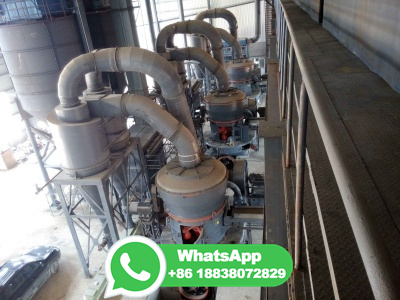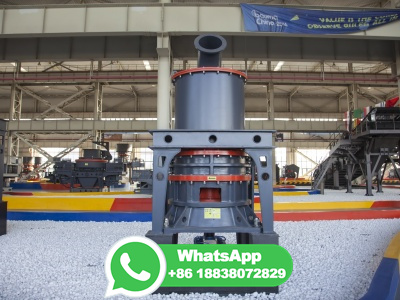
The crushed raw materials are mixed and stored for homogenization purpose, then milled together using raw mill (ball or vertical) to produce 'raw meal' under a strict quality control of the material chemistry. Hot flue gases coming from the rotary kiln, which is in the opposite direction with the material flow, preheat the
WhatsApp: +86 18838072829
cement. Hence, one grinding compartment will generally suffice. For a coal mill, we usually recommend a light classifying liners and for raw mills we recommend heavy classifying liners. If the raw materials are particularly coarse, a mixed solution might be best. This could be either by replacing the first few rings , the first
WhatsApp: +86 18838072829
A cement mill (or finish mill in North American usage [1]) is the equipment used to grind the hard, nodular clinker from the cement kiln into the fine grey powder that is cement. Most cement is currently ground in ball mills and also vertical roller mills which are more effective than ball mills. History
WhatsApp: +86 18838072829
A cement mill is a fundamental component of the cement manufacturing process, playing a vital role in breaking down and grinding cement clinker into fine powder. This finely ground powder, when mixed with other materials, produces the building material we commonly know as cement.
WhatsApp: +86 18838072829
What's more, the energy consumption of raw material grinding in the wet process is reduced by nearly 30%. Disadvantages: the heat consumption of the wet process is too high, usually between J/kg and the consumption of ball mill vulnerable parts is also large. Compared with other processing methods, the clinker manufactured by the ...
WhatsApp: +86 18838072829
Wide variation (standard deviation) in raw material composition Crushing: Wide variation in crushed material size. Mill Feeding: Periodic variation in composition and size of material. Grinding in Ball Mill: First chamber loading and consequently jamming. Blending Silo: Mill variation affecting kiln stability quickly. Coal Mill: Mill Bag filter ...
WhatsApp: +86 18838072829
Cement Ball Mill Structure. When Ball Mill is working, raw material enters the mill cylinder through the hollow shaft of the feed. The inside of the cylinder is filled with grinding media of various diameters (steel balls, steel segments, etc.); when the cylinder rotates around the horizontal axis at a certain speed, Under the action of centrifugal force and friction force, the medium and the ...
WhatsApp: +86 18838072829
What is the cement ball mill? The cement ball mill is mainly used for grinding the finished products and raw materials of cement plants, and is also suitable for grinding various ore and other grindable materials in industrial and mining enterprises such as metallurgy, chemical industry, and electric power. Cement grinding is the last process of cement production, it is to mix cement clinker ...
WhatsApp: +86 18838072829
The quality of cement clinker is directly related to the chemistry of the raw materials used. Around 8090% of raw material for the kiln feed is limestone. Clayey raw material accounts for between 1015%, although the precise amounts will vary. Magnesium carbonate, which may be present in limestone, is the main undesirable impurity. The level
WhatsApp: +86 18838072829
This ensures that only the required quantities are extracted and added to the raw material. 04 Raw Mill Building. The raw material is finishground before being fed into the kiln for clinkering. This grinding is done using either ball mills or vertical roller mills (VRM). The raw material is simultaneously dried.
WhatsApp: +86 18838072829
Production Capacity: 15100t/h Feeding Size: ≤25mm Application: limestone, cement clinker, gypsum, slag, ore, etc. get price! Ball mills, also known as tube mills, are widely used in cement, silicate products, new building materials, refractory materials, fertilizers, black and nonferrous metal dressings, and glass ceramics industry.
WhatsApp: +86 18838072829
Raw Ball Mill by BNN—A "Conscious Lab" Approach. Materials 2021, 14, 3220. https:/// /ma Abstract: In cement mills, ventilation is a critical key for maintaining temperature and material transportation.
WhatsApp: +86 18838072829
Abstract. Cement sector in india is enjoyign success and capacity enhancement due to the rapidly growing demand in various sectors but at the same time a threat is approaching to cement industry that its input cost is increasing day by day like power cost, fuel cost, raw material cost. Also cement is a highly energy consuming industry.
WhatsApp: +86 18838072829
Vertical Raw Mill. Feeding size: 35110mm. Capacity: 12350t/h. Motor power: kW. Applications: It can be used for grinding limestone, gypsum, siliceous, coal and other materials. It is mainly used in cement raw materials grinding section of cement factory, and also be used in concrete and mineral fields. Email: info
WhatsApp: +86 18838072829
Grinding mill is the core equipment of raw material preparation, which will directly affect the production efficiency and quality of cement. In current cement plants, the vertical roller mill grinding system, roller press grinding system, and ball mill grinding system are the most frequently used and most efficient grinding systems.
WhatsApp: +86 18838072829
Ball Mills. Although ball mills were first introduced in the 1860's, the main progress was made during the 1870's to 1900's in Germany, where its growing cement and chemical industries ...
WhatsApp: +86 18838072829
mostly performed in closed circuits: The ball cement mill (CM) is fed with raw materials. The milled product is fed via a recycle elevator to a dynamic separator. The high fineness stream of the separator constitutes the final circuit product, while the coarse material returns back to the CM to be ground again.
WhatsApp: +86 18838072829
In the wet process of cement production, raw materials should be ground into raw slurry with a water content of 30% 40%. While in the dry process of cement production, they will be ground into dry powder in cement raw mill. Raw mill in the dry process: cement ball mill, cement vertical mill, Raymond mill, etc.
WhatsApp: +86 18838072829
In this process, the raw materials are first reduce in size of about 25 mm in crushers. A current of dry air is then pass over these dry materials. These dry materials are then pulverise into fine powder ball mills and tube mills. All these operations are do separately for each raw material and they are store in hoppers.
WhatsApp: +86 18838072829
The cement roller press and cement mill are used to grind the cement raw material to the required particle size and packaging. There are two types of cement mill including a ball mill and vertical cement mill. The packing machine is used to pack the finished cement product into a bag according to a certain weight.
WhatsApp: +86 18838072829